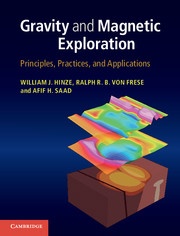14 - Applications of the gravity and magnetic methods
from Part III - Applications
Published online by Cambridge University Press: 05 May 2013
Summary
Introduction
The nature of terrestrial gravity and magnetic fields, the underlying principles of applying these fields to exploring the Earth, and an overview of the current practices for using these methods form the subject of the previous chapters. In addition to these principles and practices, a review of the applications of these methods of exploration is important to understanding them and their role in determining the nature, composition, and structure of the Earth. In this chapter, a brief introduction is given of the application of gravity and magnetic methods to subsurface exploration. It serves as an introduction to a website that accompanies this book, which can be accessed at http://www.cambridge.org/gravmag. The website presents an expanded explanation of the applications of the methods and examples of their application largely from published case histories. Providing the case histories on a website decreases the length of the book, allows the inexpensive use of color in illustrations, and makes it easier to update the material with new applications. The reader is urged to visit the website and study the representative examples of the application of gravity and magnetics as a useful adjunct to understanding the methods.
General view of applications
Geophysical methods have had a seminal role in determining the nature of the Earth, leading to our current state of knowledge about the origin and evolution of our planet and the processes involved in the Earth system.
- Type
- Chapter
- Information
- Gravity and Magnetic ExplorationPrinciples, Practices, and Applications, pp. 415 - 421Publisher: Cambridge University PressPrint publication year: 2013



